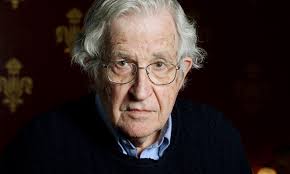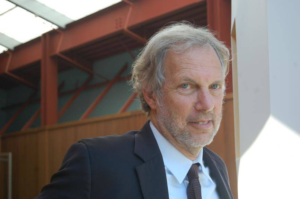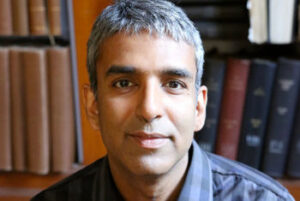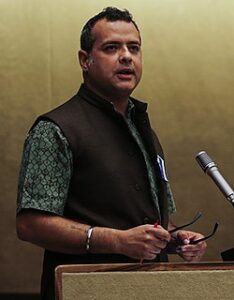
Noam Chomsky
The report from the UN Intergovernmental Panel on Climate Change shows how capitalism undergirds the climate crisis.
The UN Intergovernmental Panel on Climate Change (IPCC) has released a new climate report which updates and combines the findings from all past reports in the IPCC’s sixth assessment. The synthesis report urges immediate action to curb global warming and secure a livable future for all. In this exclusive interview for Truthout, Noam Chomsky and Robert Pollin offer remarkable insights on what the new IPCC report means and implications for action, on both the political and financial front, that its findings entail.
Noam Chomsky is institute professor emeritus in the department of linguistics and philosophy at MIT and laureate professor of linguistics and Agnese Nelms Haury Chair in the Program in Environmental and Social Justice at the University of Arizona. One of the world’s most cited scholars in modern history and a critical public intellectual regarded by millions of people as a national and international treasure, Chomsky has published more than 150 books in linguistics, political and social thought, political economy, media studies, U.S. foreign policy and world affairs, and climate change. Robert Pollin is distinguished professor of economics and co-director of the Political Economy Research Institute (PERI) at the University of Massachusetts-Amherst. One of the world’s leading progressive economists, Pollin has published scores of books and academic articles on jobs and macroeconomics, labor markets, wages and poverty, and environmental and energy economics. He was selected by Foreign Policy Magazine as one of the “100 Leading Global Thinkers for 2013.” Chomsky and Pollin are co-authors of Climate Crisis and the Global Green New Deal: The Political Economy of Saving the Planet (2020).
C.J. Polychroniou: The IPCC has just released a synthesis report which is based on the content of its Sixth Assessment Report, i.e., contributions from the Three Working Groups and the three Special Reports. In sum, we have a synthesis report of scientific assessments on climate change published since 2018, except that the new report paints an even more troubling picture: We are closer than ever before to reaching or surpassing a 1.5-degree Celsius temperature rise and “continued emissions will further affect all major climate system components.” Drawing on the findings of hundreds of scientists that have contributed to the IPCC’s Sixth Assessment Report (AR6), the IPCC’s synthesis report states that “in the near term, every region in the world is projected to face further increases in climate hazards (medium to high confidence, depending on region and hazard), increasing multiple risks to ecosystems and humans (very high confidence).” Accordingly, the authors of the synthesis report assert that limiting global warming requires “net zero” carbon dioxide emissions and that the window of opportunity “to secure a livable and sustainable future for all” is “rapidly closing” and call for urgent climate action on all fronts. Indeed, in the synthesis report, its authors contend that there are major opportunities “for scaling up climate action” and only lack of political will is holding us back.
Noam, what are your thoughts on the new IPCC report? I don’t suppose you are surprised by any of its findings or policy recommendations.
Noam Chomsky: IPCC reports are consensus documents. Hence, they tend to err on the side of understatement. This one strikes me as different. It seems that desperation within the scientific community has reached such a level that the gloves are off and they feel the time has come to be blunt. Time is brief. Decisive action is an urgent necessity. Opportunities exist. If they are not taken, vigorously, we might as well say: “Too bad, was nice knowing you.”
The report highlights the failure of “political will.” Fair enough. If we care enough about decent survival to act decisively, we should take a close look at this concept and what it means for existing societies; or better, for societies we have some hope of attaining within the constraints of the time span for necessary action. We must, in short, have a clear understanding of the institutional structures within which political will can have concrete consequences.
Where is political will exercised? In the streets, to adopt the familiar metaphor, meaning among an informed, active, organized public. Insofar as that form of political will is exercised, it may — in this case, must — reach and influence centers of power, private and state, closely linked.
Let’s be concrete. Congress just passed “landmark legislation” on climate, the Inflation Reduction Act (IRA) of 2022. It is hailed as the most significant clean energy and climate legislation in the history of the nation, “a new day for climate action in the United States.”
That is accurate. It is also a sad commentary on the history and prospects for “climate action.”
While not without positive features, the Act is a pale shadow of the legislation proposed by the Biden administration under the impetus of intense popular activism, channeled primarily through Bernie Sanders’s office. In related developments, similar initiatives reached Congress in the Green New Deal Resolution reintroduced in 2021 by Alexandria Ocasio-Cortez and Ed Markey.
The Biden proposal would indeed have been “landmark legislation” had it been enacted. While insufficient in light of the emergency we face, it would have been a long step forward. It was cut down step-by-step by 100 percent Republican opposition to anything that might address the most severe crisis of human history — and infringe on their passionate service to extreme wealth and corporate power. Joined by a few right-wing Democrats, GOP radicalism succeeded in removing most of the substance of the original proposal.
To understand our political institutions, it is important to recall that adamant GOP dedication to environmental destruction is not mere sociopathic sadism. In 2008, Republican presidential candidate John McCain introduced a limited climate initiative in his program, and congressional Republicans were also considering some measures.
For years, the huge Koch brothers’ energy conglomerate had been working hard to ensure that the GOP would not veer from climate denialism. When they heard of this deviation, they launched a juggernaut to restore orthodoxy: bribery, intimidation, lobbying, astroturfing, all the devices available to unaccountable concentrated economic power. It worked, quickly and effectively. From then until today it’s hard to detect any GOP departure from abject service to the demand of concentrated power that we must race to destruction (and profit, during the few years ahead in which it will matter).
This is perhaps an extreme example, but it is not very far from the norm in the reigning form of state capitalism. That is particularly so in the era of savage capitalism called neoliberalism, basically a form of bitter class war disguised in grossly misleading terminology of “free markets,” as practice reveals with brilliant clarity.
Returning to the IRA, one basic component is an array of devices to induce the fossil fuel industry and financial institutions that support it to please act more nicely. The devices are mainly bribery and subsidy, including the gift of federal lands to exploit for oil extraction for decades to come, long after we pass tipping points for irreversible climate destruction.
The choice of tactics is understandable given existing institutional structures. It is well understood in the elite culture that all concerns must be subordinated to the welfare of the masters of the private economy. That is Moses and the Prophets, to paraphrase Marx. Unless the masters are happy, we are lost.
During World War II, the whole of society was mobilized for the war effort. But as Secretary of War Henry L. Stimson observed, “If you are going to try to go to war, or to prepare for war, in a capitalist country, you have got to let business make money out of the process or business won’t work.” Business leaders were called upon “to run the agencies that coordinated production, [but] they remained on company payrolls, still cognizant of the interests of the corporations they ran. A common pattern, which provided an incentive to businesses to cooperate, was the cost-plus-a-fixed-fee system, whereby the government guaranteed all development and production costs and then paid a percentage profit on the goods produced.”
First things first. It is important to win the war, but more important “to let business make money out of the process.” That is the real Golden Rule, the Rule that must be observed, not only during the most destructive war in history, but even in the far greater war in which human society is now engaged: the war to preserve organized human life on Earth.
The highest principle of our institutional structures also reveals their intrinsic lunacy. It is as if the Mexican government were to appeal to the drug cartels to reduce their mass slaughter by offering them some bribes and payments.
We can hardly be surprised that when oil prices shot up after Putin’s invasion of Ukraine, the oil companies politely informed us: Sorry folks, No Dice. Their bulging profits could be enhanced even further by curtailing their very limited commitment to sustainable energy and running after the big money, whatever the consequences for life on Earth.
It is all too familiar. We may recall the COP26 Glasgow UN Conference on climate in October 2021. U.S. delegate John Kerry was ecstatic that the market was now on our side. How can we lose? BlackRock and other asset managers were promising to provide tens of trillions of dollars to the cause of sustainable development — with two small provisos: their benevolent investments must be profitable, and accompanied by firm guarantees that they will be risk-free. All thanks to the friendly taxpayer, who is regularly called upon to ride to the rescue in our neoliberal bailout economy, to adopt the phrase of economists Robert Pollin and Gerald Epstein.
I’ve occasionally cited Adam Smith’s observation that in all ages, the “masters of mankind” — those who hold economic power — adhere to their “vile maxim”: “all for ourselves, nothing for other people.”
In the present context, the observation is a little misleading. Rulers with supreme power can afford some degree of benevolence to their subjects, even at a cost to their immense wealth. Capitalist systems do not permit such deviation from the vile maxim. The basic rules are that you pursue profit and market share, or you’re out of the game. Only insofar as an organized public compels bending of the rules can we expect deviation from the vile maxim.
Many have expressed puzzlement that CEOs of fossil fuel companies and the banks that lend to them can consciously sacrifice their grandchildren to amassing even more wealth than what already surpasses the dreams of avarice. They can offer a convincing answer: Yes, that’s what I’m doing, but if I depart from this practice, I will be replaced by someone who keeps to it, and who may not have my good will, which might mitigate the tragedy somewhat.
Again, it is the lunacy of the institutions that prevails.
We can add some of Adam Smith’s closely related words of wisdom: thanks to their control of the economy, the masters of mankind become the “principal architects” of state policy and ensure that their own interests are “most peculiarly attended to” no matter how “grievous” the effects on others. Hardly an unfamiliar sight.
he same unaccountable power has a substantial impact on prevailing doctrines, what Gramsci called “hegemonic common sense.” Polls show that voters who identify as Republicans have little concern for “climate change” — to adopt the conventional euphemism for boiling the planet. That’s not too surprising. What they hear from their leaders and echo chambers like Fox News is that if climate change is even happening, it hardly matters. It’s just another concoction of “liberal elites” in their insidious campaigns, along with “grooming” of children by the “sadistic pedophiles” who run the Democratic Party (believed by almost half of GOP voters), fostering the “Great Replacement” to destroy the repressed white race, and whatever may be devised next to keep the rabble in line while legislative programs stab them in the back.
I don’t want to suggest that the GOP is alone in the infamy. Far from it. They have just driven class war to extremes that would be comical if the impact were not so ominous.
I mentioned one component of the IRA: gifts and subsidies to the malefactors to induce them to act more nicely. There is a second component: industrial policy, a radical departure from professed neoliberal doctrine. In this case, substantial subsidies to private power to restore a domestic chip industry. That raises further questions: Should the profits from public largesse be directed to the pockets of wealthy shareholders and stock options for the super-rich management class? Or should the social product be distributed differently, including the forgotten general public? Questions that shouldn’t be overlooked.
Also not to be overlooked is the broader context of the effort to reconstruct part of the industrial economy that was dispatched abroad by the masters of the economy for their own welfare. The effort is part of the broader commercial war against China, designed to prevent its economic development. One priority in that war is to coerce European, Korean and Japanese advanced industry to give up their major market and source of raw materials in China in order to serve Washington’s campaign to preserve global hegemony. How this will turn out, we do not know. But it merits attention and thought.
These are broad brush strokes, overlooking much of great import. Nevertheless, I think the general picture is a useful framework for thinking about the tasks ahead. One plausible conclusion is that there is little hope within the institutional structure of savage capitalism. Can this be changed sufficiently within a realistic time span, with the savage element of the amalgam reduced or eliminated? It’s hardly utopian to think that the savagery can be reversed with a return to something like the capitalism of the Eisenhower years, which, with all its severe flaws, is regarded with some justice as the “golden years” of state capitalism. Taming the worst excesses of the class war of the past decades is surely feasible.
Would that suffice to allow the “political will” of the streets to deter the worst, to open the way to the better future that can realistically be envisioned? There’s only one way to find out: Dedication to the task.

Robert Pollin
Bob, what are your own thoughts on the new IPCC report? Can “net zero” carbon dioxide emissions be reached across all sectors before mid-century? If so, where do we start, and how? But before you answer this part of the question, does “net zero” mean zero emissions? To be sure, is there such a thing as “net zero” or “zero carbon?”
Robert Pollin: For 2022, total global carbon dioxide (CO2) emissions reached 40.5 billion tons. Of this total, 36.6 billion tons, or 90 percent of all 2022 CO2 emissions, were produced by burning oil, coal and natural gas to produce energy. The remaining 3.9 billion tons, equal to 10 percent of the total, were generated by land use changes, primarily deforestation to clear land for corporate agriculture and mining. The 2022 global emissions total was slightly below the peak figure for 2019, i.e., the year just prior to the COVID lockdown. Global emissions did fall in 2020 due to the lockdown, but only by about 6 percent, and then began rising again in 2021, as the global economy emerged out of the lockdown. Since its landmark 2018 report, the IPCC has become increasingly insistent that, in order to have even a reasonable chance of stabilizing the rise in the average global temperature by 1.5 degrees Celsius relative to pre-industrial levels, global CO2 emissions need to be cut roughly in half, to 20 billion tons, as of 2030 and then to reach “net zero” emissions by 2050.
You are absolutely on target to ask what exactly the term “net zero” really means here. In fact, by itself, that one small word “net” in the phrase “net zero emissions” creates massive opportunities for fudging and outright obfuscation around climate solutions. Fossil fuel producers and anyone else now reaping profits from selling fossil fuels are committed to exploiting these obfuscation opportunities to the maximum.
The point is that the term “net zero” allows for scenarios in which CO2 emissions remain at some significant positive level by 2050, i.e., that we are still burning oil, coal and natural gas to produce energy and are still razing forested areas, starting with the Amazon rainforest. The way we would supposedly reach net zero emissions under such scenarios would entail extracting the ongoing emissions out of the atmosphere through various measures falling under the term “carbon capture” technologies.
What are carbon capture technologies? To date, there is exactly one, and only one, such technology that has been proven to be effective and safe. That is to plant trees. More specifically, I am referring to afforestation — i.e., increasing forest cover or density in previously non-forested or deforested areas. Reforestation, the more commonly used term, is one component of afforestation. Afforestation works for the simple reason that living trees absorb CO2. This is also why deforestation releases CO2 into the atmosphere, contributing to global heating.
The big question with afforestation is, realistically, how large can its impact be as a means of counteracting ongoing CO2 emissions from burning fossil fuels? One careful study by Mark Lawrence and colleagues at the Research Institute for Sustainability in Potsdam, Germany, concludes that afforestation could realistically reduce CO2 levels by between 0.5 and 3.5 billion tons per year through 2050. As noted above, current global CO2 levels are at about 40 billion tons. If the estimate by Lawrence and coauthors is even approximately correct, it follows that afforestation can certainly serve as a complementary intervention within a broader climate program. But afforestation cannot bear the major burden of clearing the atmosphere of CO2 if we continue to burn fossil fuels to any significant extent.
Beyond afforestation are a range of high-tech measures that, according to its fossil fuel industry proponents, will be able to capture CO2 and then either store it in underground reservoirs for all time or recycle and reuse it as a fuel source. However, none of these technologies are close to being capable of operating on a commercial basis at scale, despite the fact that, for decades, the fossil fuel companies have had huge incentives to make these technologies work.
In fact, in the final drafting of the most recent IPCC report, fossil-fuel producing countries lobbied hard to feature carbon capture technologies as a major climate solution. Still further, the upcoming global climate conference, COP28, will be held in November and December 2023 in the United Arab Emirates (UAE). The COP28 president-designate Sultan al-Jaber, who is also the head of the UAE’s state-owned oil company Adnoc, has been, according to the Financial Times, “consistent in stressing the need for a reduction in emissions rather than a reduction in fossil fuel production.” In other words, according to al-Jaber, Adnoc and other oil-producing companies should be allowed to keep swimming in oil profits while we gamble the fate of the planet on technologies that don’t work now and may never work. The latest IPCC report itself concluded that global rates of carbon capture deployment are “far below” what is needed for any viable climate stabilization project. The IPCC emphasized that implementation of carbon capture and storage “faces technological, economic, institutional, ecological, environmental and sociocultural barriers.”
Let’s now return to the first part of your question: whether net zero emissions are achievable by 2050 when we allow that afforestation can, at most, extract 5 to 10 percent of the current level of emissions from burning fossil fuels? In other words, is it possible to effectively eliminate fossil fuel consumption throughout the global economy by 2050? The short answer is, yes. I say this even while recognizing that, at present, about 85 percent of current global energy supplies are produced by burning oil, coal and natural gas. We also need to allow that people are still going to need to consume energy to light, heat and cool buildings; to power cars, buses, trains and airplanes and to operate computers and industrial machinery; among other uses.
Still, purely as an analytic, economic and policy challenge — i.e., independent of all the forces arrayed to defend fossil fuel profits at all costs — it is entirely realistic to allow that global CO2 emissions can be driven to net zero by 2050. By my higher-end estimate, it will require an average level of investment spending throughout the global economy of about 2.5 percent of global GDP per year to build a global clean-energy infrastructure to supplant our existing fossil-fuel dominant infrastructure. That translates into about $2 trillion in today’s global economy, and an average of about $4.5 trillion per year between now and 2050. This is obviously a lot of money. But, as a share of annual GDP, it is about one-tenth of what the U.S. and other high-income countries spent to prevent an economic collapse during the COVID lockdown. These investments should be focused on two areas: 1) dramatically improving energy efficiency standards in the stock of buildings, automobiles and public transportation systems and industrial production processes; and 2) equally dramatically expanding the supply of clean renewable energy sources — primarily solar and wind power — available to all sectors and in all regions of the globe, at competitive prices relative to fossil fuels.
These investments are centerpieces of the global Green New Deal. As such, they will also be a major new source of job creation in all regions of the world. This is because building a new global energy infrastructure requires people at work doing their jobs — all kinds of jobs, across the board, including roofers, plumbers, truck drivers, machinists, accountants, office managers, train engineers, researchers and lawyers. In fact, building a global clean-energy infrastructure requires about two to three times more people to do these jobs than to maintain our existing fossil fuel-dominant energy infrastructure.
The global clean energy transition will also deliver cheaper energy. The U.S. Energy Information Administration predicts that the overall cost of generating a kilowatt-hour of electricity from solar or wind power will be roughly half that of coal and nuclear power by 2027. Raising efficiency standards on top of the clean energy investments also means that operating our various types of machinery requires us to buy less energy, any kind of energy — e.g., fewer kilowatt hours to warm, cool and light buildings, or transport ourselves from one place to the next. Small-scale, low-cost clean energy infrastructures can also be built in the roughly 30 percent of rural areas in developing countries that, to date, still do not have access to electricity.
As we discussed recently, there have been major positive developments over the past year, with clean energy investments having grown rapidly in both the U.S. and Western Europe. Yet, at the same time, the profits of the major oil companies reached an all-time high in 2022 of $200 billion. Moreover, politicians continue to genuflect before the oil companies. President Biden’s decision to approve the huge Willow oil drilling project on federally owned land in Alaska is the most recent case in point. This is after Biden had campaigned in 2020 on a pledge of “no more drilling on federal lands, period.”
In short, true net zero emissions — with the “net” referring only to CO2 absorption through afforestation at a level of perhaps 5 to 10 percent of current emissions — is entirely feasible technically and economically. But it will continue to be a massive political struggle. Rhetoric notwithstanding, the fossil fuel corporations — the public companies like Adnoc in the UAE as well as the private companies like ExxonMobil — have no intention of relinquishing their profits in the name of saving the planet.
Noam, what Bob just said about the transition to a green economy sounds very logical to me, but as the new IPCC report clearly states, such action entails not merely access to major sources of funding and technology but also coordination at all levels of governance, consensus among diverse interests, and of course, international cooperation. Obviously, humanity has in front of it a herculean task. And I suppose many would say that it is not realistic to expect so much out of human nature and today’s political institutions. What would be your reply to such rather pessimistic but not necessarily thoughtless considerations given the political history of the world?
Noam Chomsky: The crucial phrase is “human nature and today’s political institutions.” On the latter, it’s hard to see much hope under today’s political institutions, that is, the savage capitalism instituted under the bitter class war misleadingly called “neoliberalism.” There is no need to review again its deleterious impact. As usual, the most brutal punishment has been administered to the most vulnerable in the rich societies and particularly beyond. Much of the Global South had to endure harsh structural adjustment programs with effects ranging from the “lost decades” in Latin America to severe disruptions of the social order in Yugoslavia and Rwanda that are a large part of the background for the horrors that followed.
Many defend and even highly praise the “neoliberal” era. Of course, we expect that among the beneficiaries of the highway robbery that transferred an estimated $50 trillion from the working and middle classes in the U.S. to the top 1 percent, according to the Rand corporation study that we’ve discussed. But defenders extend to serious analysts, who rightly hail the lifting of hundreds of billions of people from poverty — overwhelmingly in China, not exactly a model of the “free market capitalism” hailed by neoliberal enthusiasts.
Also overlooked is that the methods adopted to bring about this welcome result, along with the great harm it imposed, were not dictated by “sound economics.” The driving force was again the vile maxim. The optimal way to pursue it is to set working people in competition with one another while offering enormous gifts to capital. These include the highly protectionist investor rights agreements of the Clinton years, absurdly called “free trade agreements.” Detailed alternatives were proposed by the labor movement and Congress’s own research bureau, the Office of Technology Assessment (quickly dismantled). These alternative programs aimed to create a high-growth, high-wage international economy in which working people of all countries would benefit. In the era of bitter class war, they were not even considered.
We can reasonably conclude that savage capitalism offers little hope for survival.
The best hope, as mentioned earlier, is to defang the savagery while recognizing that dismantling the anti-human capitalist order is a longer-term and continuing project. That project does not conflict with the urgent task of mitigating the savagery. On the contrary, the two efforts should be mutually reinforcing.
What can we say, then, about the role of human nature? In some domains, quite a lot. A good deal has been learned about fundamental human cognitive nature, but these discoveries at most provide some suggestive hints in the domains that concern us here, where little can be said with much confidence.
If we look over history, we see vast differences in what accords with human nature. Behavior that was considered normal in the past arouses horror today. That’s true even of the recent past. A dramatic illustration of the range of options that accord with basic human nature is Germany. In the 1920s, it represented the peak of Western civilization in the arts and sciences, and was also regarded as a model of democracy. A decade later it descended to the depths of depravity. A decade after that it was returning to an earlier course. The same people, the same genes, the same fundamental human nature, differently expressed with changing circumstances.
There are innumerable examples. One case of great relevance to our current discussion is attitudes towards employment. After four decades of the neoliberal assault, it is a high aspiration to find relatively secure employment instead of being left to the precarity designed by contemporary savage capitalism. A century earlier, in the aftermath of World War I, there were major efforts in Western industrial societies to create a very different social order in which working people would be freed from the fetters of capitalist autocracy: guild socialism in England, worker-run enterprises in Italy, many other initiatives. They posed a serious threat to the capitalist order. The initiatives were crushed in many ways. In the U.S., the extreme violence of Wilson’s Red Scare crushed a vibrant labor movement along with social democratic politics, with some revival in the New Deal years but under constant bitter assault.
In earlier years, working people regarded having a job — that is, subordination to a master for most of one’s waking life — as an intolerable attack on elementary human rights and dignity, a form of virtual slavery. “Wage slavery” was the conventional term. The slogan of the first great U.S. labor organization, the Knights of Labor, was that “they who work in the mills should own them.” Working people should not be subject to the orders of the masters of mankind. At the same time, radical farmers were organizing to free themselves from the grip of northeastern bankers and market managers, seeking to create a “cooperative commonwealth.” These were the authentic Populists.
There were promising steps to bring together the agrarian and industrial popular classes. As throughout American history, these efforts were crushed by state and private power. American society is unusual among industrial societies in the power of the masters of the economy and their high level of class consciousness, a feature of American exceptionalism among industrial democracies that has many ramifications.
The transition from regarding subordination to a master as an intolerable attack on basic human dignity and rights to seeking it as the highest aspiration in life involved no change in human nature. Same human nature. Different circumstances.
Progressing to a livable society should enhance many aspects of our fundamental nature: mutual aid, sympathy for others, the right to participate freely in determining social policy, and much else. At the same time, it will inevitably limit other options that for many are important parts of a meaningful existence.
Transition to a sustainable economy is an inescapable necessity. It can be achieved in a manner that will provide a much better life. But it will not be easy, or without significant burdens.
Bob, finance is key to containing global warming. Yet, the world economy is always in the midst of some sort of crisis or another, and nowadays, a new banking crisis may be underway. Is there sufficient global capital and liquidity to overcome political inaction so global emissions can be reduced by over 40 percent by 2030, which seems to be an absolute must if a climate breakdown is to be averted?
Robert Pollin: There are certainly more than sufficient financial resources that could be mobilized to pay for a full-scale clean energy transition. As I noted above, we need to channel about 2.5 percent of global GDP per year into clean energy investments. This compares with the high-income economies having injected about 25 percent of GDP into bailout operations during the COVID lockdown. As it is, global subsidies for fossil fuels doubled in 2022 to $1.1 trillion. Repurposing just these funds into supporting clean energy consumption and investments, as opposed to continuing to underwrite oil company price gouging and profiteering, could itself provide nearly half the funding required in the current global economy.
Under effective policies, the latest banking sector turmoil in the U.S. and Europe should not create any barrier to channeling large-scale funding into clean energy investments. To the contrary, effective policies can enable clean energy investments to become a low-risk safe haven for investors, as they should be. This can then serve to help stabilize the financial system overall.
As one example, the U.S. government could issue green bonds, which would then carry zero risk of default for private holders of these bonds, as with all other U.S. Treasury securities (assuming the U.S. House Republicans still possess the minimal sliver of sanity necessary to enable the federal government’s debt ceiling to rise). The government could then utilize these funds, as one example, to procure solar and wind power from private firms to supply the government’s electricity consumption needs. Private clean energy suppliers would then operate with long-term guaranteed fixed contracts with the government. This would serve as another source of stability within the financial system. Because the government would be guaranteeing these markets, the profits of the clean energy suppliers would then also be regulated and limited, as they are now for public utilities.
The federal government could also channel a significant share of its green bond funds to developing economies. This would enable those of us in rich countries to meet our obligation to help finance the clean energy transformation in these economies, given that the U.S. and other rich countries are almost entirely responsible for having created the climate crisis in the first place. At the same time, the green bonds used for this purpose would still be U.S. Treasury securities, and would therefore still carry zero default risk.
Similar green bond initiatives could also readily be undertaken in all high-income economies. The overall impact would be to stabilize the global financial system with safe government-backed investments that also happen to be fulfilling the vital function of advancing the global climate stabilization project, as opposed to feeding yet more useless speculative frenzies on Wall Street.
Source: https://truthout.org/
C.J. Polychroniou is a political scientist/political economist, author, and journalist who has taught and worked in numerous universities and research centers in Europe and the United States. Currently, his main research interests are in U.S. politics and the political economy of the United States, European economic integration, globalization, climate change and environmental economics, and the deconstruction of neoliberalism’s politico-economic project. He is a regular contributor to Truthout as well as a member of Truthout’s Public Intellectual Project. He has published scores of books and over 1,000 articles which have appeared in a variety of journals, magazines, newspapers and popular news websites. Many of his publications have been translated into a multitude of different languages, including Arabic, Chinese, Croatian, Dutch, French, German, Greek, Italian, Japanese, Portuguese, Russian, Spanish and Turkish. His latest books are Optimism Over Despair: Noam Chomsky On Capitalism, Empire, and Social Change (2017); Climate Crisis and the Global Green New Deal: The Political Economy of Saving the Planet (with Noam Chomsky and Robert Pollin as primary authors, 2020); The Precipice: Neoliberalism, the Pandemic, and the Urgent Need for Radical Change (an anthology of interviews with Noam Chomsky, 2021); and Economics and the Left: Interviews with Progressive Economists (2021).






